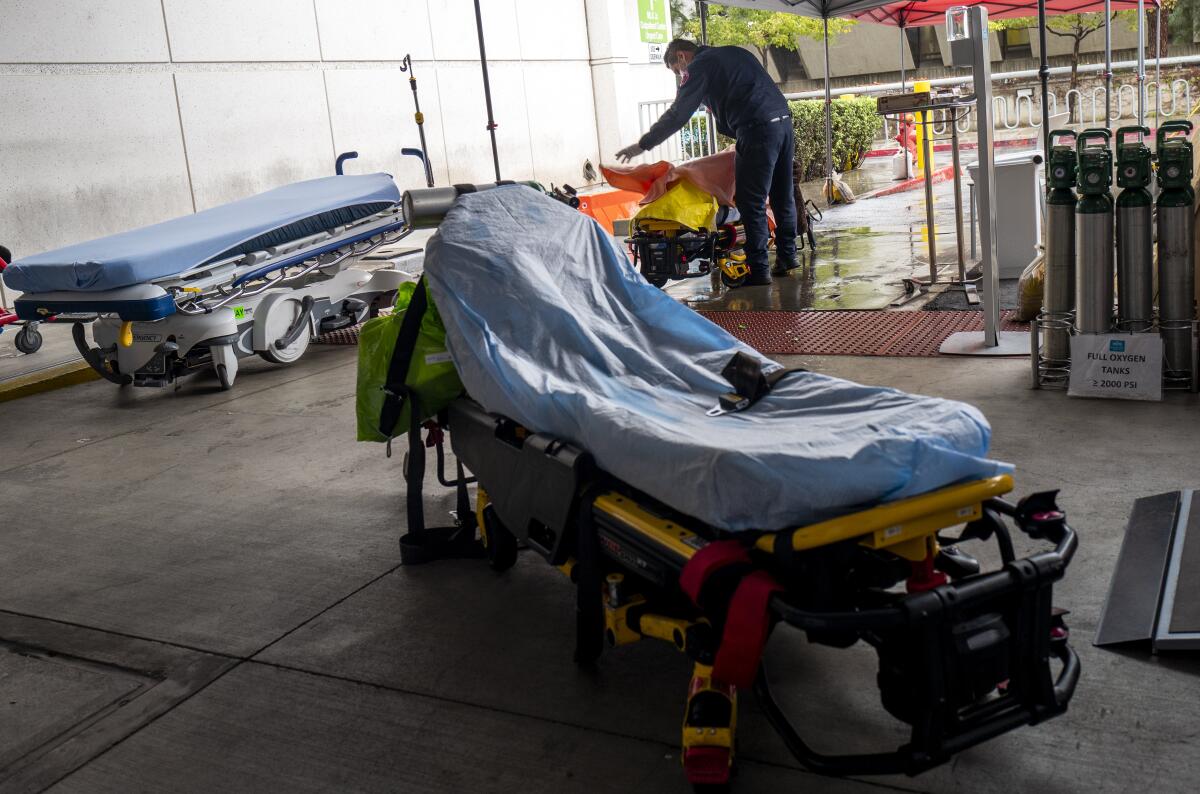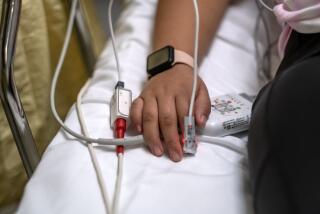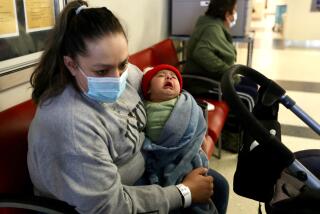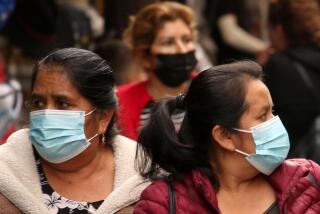Even as Omicron starts to ease in California, hospitals facing grim conditions

- Share via
Even amid signs that this winter’s Omicron-fueled wave may be starting to crest in California, the situation at hospitals like Sharp Grossmont Hospital in La Mesa is worsening.
Patients are sometimes waiting a day or two to be admitted and get a bed. Nursing homes are rebuffing the hospital’s requests to transfer recovering patients, saying they are short-staffed themselves because of the coronavirus. Across the Sharp health system, one of the largest in San Diego County, more than 1,000 health workers are now unable to work because of coronavirus-related reasons.
At Olive View-UCLA Medical Center in Sylmar, registered nurse Sandra Beltran said short staffing has led patients treated in the emergency room to sometimes wait 20 or 30 hours for a bed elsewhere in the hospital. That has a domino effect on the ER, where waits grow longer and staff have had to find new ways to assess patients.
“People are being seen in the hallway,” Beltran said. “It’s tiring. You’re literally, for 12 hours, going from room to room.”
Even amid growing signs Omicron is leveling off in California, new data show the total number of people hospitalized statewide is approaching the peak of last winter’s COVID-19 surge.
Late last week, California averaged 52,000 people daily in its hospitals for all reasons — more than were seen during any seven-day period during the summer Delta surge. The state is now nearing its pandemic record of 55,000 people hospitalized, set last winter, according to state Department of Public Health data reviewed by The Times.
Coronavirus-positive patients continue to account for a large portion of the overall census. As of Tuesday, 15,179 such patients were hospitalized statewide, the highest since Jan. 29, 2021, state data show.
Many hospital emergency rooms have been so crowded, and staffing so scarce because of employee infections, that a number of scheduled surgeries and procedures have been postponed. Those delays can affect the health of people needing treatment for cancer or other important medical issues, in which prompt care can make a difference.
Demand for emergency room care has reached records not seen even in last winter’s devastating wave. A little more than a week ago, California was averaging nearly 47,000 visits a day in its emergency rooms for all reasons; a year earlier, the figure was about 32,000.
Visits by people seeking emergency care for coronavirus-related reasons has more than doubled since the Omicron surge began, with nearly 12,000 visits a day recorded recently. That’s even worse than experienced last winter, when there were nearly 11,000 visits a day.
Hospital officials acknowledge the medical consensus that for any given patient, Omicron is less likely to cause severe illness than earlier variants. But California is now experiencing such a gigantic wave of simultaneously infected people that hospitals are still overloaded. The pace is unprecedented, with 1 million coronavirus cases recorded just last week; last winter, more than three weeks passed for 1 million cases to be reported.
“I think there’s a perception in the community that [Omicron] is not as serious,” said Dr. Jeffrey Smith, Cedars-Sinai Medical Center’s vice president of operations and chief operating officer. “But it is still the burden on the health system, be it the emergency medical services or the ambulances in the hospital emergency departments in the hospital themselves. It’s really just the sheer number of patients that causes challenges.”
The Los Angeles hospital has been forced to postpone some scheduled surgeries, such as for orthopedics, while still performing other procedures “like cancer surgery or heart surgery that can’t wait,” Smith said. The move needed to be done to “make sure that we have enough beds and enough staff to care for the patients.”
At Cedars-Sinai overall, 1 in 4 patients are being hospitalized for COVID-19, with most of those people either unvaccinated, partially vaccinated or not up to date with the booster shot. Almost without exception, those up to date on their shots have no need for intensive care, Smith said.
Some people dismiss the threat of Omicron, but “tell that to the 11 patients in my ICU who are fighting to survive,” said Dr. Bernard Klein, chief executive of Providence Holy Cross Medical Center in Mission Hills. “It still is a very dangerous infection.”
At Providence Holy Cross, there were only eight patients hospitalized with COVID-19 a little over a month ago. That number now exceeds 100, “a phenomenal increase in a very short period of time,” Klein said.
This time around, “what has made this surge so unique and challenging is that the Omicron variant is so infectious that it’s hitting our employees and their families,” Klein added. As of Wednesday morning, Klein said, roughly 8% of the hospital’s workforce was out and it was operating at more than 90% of its capacity.
The hospital has again set up a tent to sort patients outside, has reopened designated units to care solely for COVID patients and is holding off on inpatient scheduled surgeries that are not “emergent or urgent” — the result of shortages in both staff and blood, Klein said.
“Our ER, and pretty much every ER that I know of, is holding patients that are admitted because we don’t have a bed in the main hospital,” Klein said. That “has potentially huge ramifications,” including longer waits for new patients trying to get into the emergency room and delays in unloading ambulances and sending them back out, he said.
In Arcadia, Methodist Hospital of Southern California is licensed for more than 300 beds but was able to staff fewer than 200 on Wednesday, limiting how many patients could be admitted, Senior Vice President Cliff Daniels said.
“We continue to scramble every day to find nurses so we can staff more beds” because so many healthcare workers are either infected or caring for family, he said.
So far, the hospital has not sought to immediately bring back asymptomatic healthcare workers who have tested positive for the coronavirus — a step that California authorized to ease staff shortages at hospitals. It is, instead, relying on travel and registry nurses when it can hire them.
The staffing strain at the Arcadia hospital has collided with its growing number of COVID-19 patients, which surged from zero to 60 in the last month and a half, Daniels said.
The result is a logjam for patients being treated in the emergency room but who are ill or injured enough to need to be admitted. Daniels said the wait for people being treated in the emergency room to get a bed elsewhere in the hospital has exceeded 50 hours.
“If you can’t get people out of the hospital, then it makes it hard to get them into the hospital because the beds are blocked,” Sharp Grossmont Hospital Chief Executive Scott Evans said. “I think that people are underestimating the sheer amount of volume that hospitals are experiencing.”
“We’re holding, you know, more than 40 patients that need to go to skilled nursing facilities that we can’t send anywhere. That means we have like 35 patients in the emergency room, waiting to go up to a bed, that we can’t get into a bed,” Evans added.
At Sharp’s La Mesa hospital, officials have tried to not cancel surgeries as much as possible, especially for the heart or removal of brain tumors. Limited staffing and too few beds for postoperative care and recovery, however, can complicate matters.
The long waits for hospital care and admission have meant health workers are now contending with the ire of patients and their loved ones. The memories of health workers being honored as heroes in the early weeks of the pandemic have faded.
“People are not as, I think, appreciative necessarily or understanding as they were and respectful to the healthcare providers, as they were in the beginning of the pandemic,” Evans said. “I think that that has been sort of displaced by some anger.”
More to Read
Sign up for Essential California
The most important California stories and recommendations in your inbox every morning.
You may occasionally receive promotional content from the Los Angeles Times.














